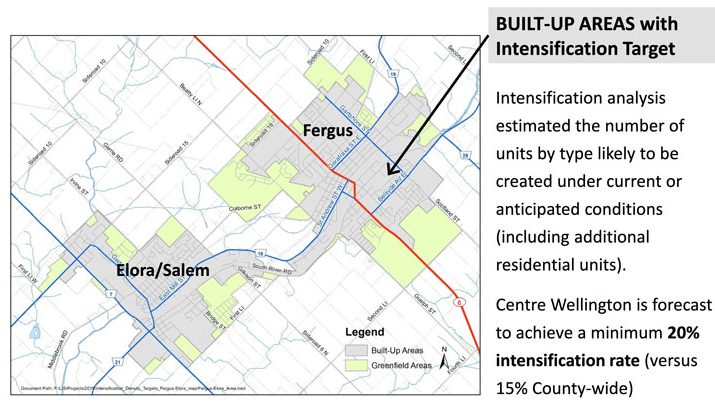ELORA – It’s not new information that Centre Wellington is going to grow over the next 30 years.
But township councillors got a better understanding of just how much growth is expected at its Jan. 30 meeting.
Wellington County manager of policy and planning Sarah Wilhelm explained the county has been working on a municipal comprehensive review to determine where the county’s share of growth, dictated by the province, will fall and what it will take to get there.
Through those studies, Centre Wellington is anticipated to add 11,260 housing units over the next 35 years and to take on nearly half of the county’s employment growth, or 14,600 jobs.
That will grow the population to 58,000 by 2051, Wilhelm said.
The county has determined Centre Wellington needs a 20% intensification rate to get there. It will also need to expand its settlement area boundaries by almost 1,000 acres (400 hectares) to accommodate that growth.
“One thousand acres sounds like a lot and all that land is prime agricultural land,” said Centre Wellington’s managing director of planning and development Brett Salmon.
“Urban expansion will come at the expense of farmland.”
There is a big parcel of land in Fergus slated for future development.
Fergus South – on both sides of Highway 6 from 2nd Line to the existing southern edge of town – will have housing, commercial space, and links to trails and, if planned thoughtfully, can take a good chunk of that growth.
Salmon said staff have been working on the Fergus South Secondary Plan and it should come to council in the coming months.
But homes and businesses will have to go other places too.
Salmon sought approval from council to retain Watson and Associates Economists to do a deeper dive into those numbers and prepare a Community Land Needs Assessment specific to Centre Wellington.
Watson’s review would assess three growth scenarios using the county’s 20% intensification rate as a base.
Eager to preserve as much farmland as possible, councillor Bronwynne Wilton asked if one of the scenarios could examine the impact of a 30% intensification rate and council agreed.
Earlier in the meeting, Elora resident Ian Rankine delegated to council on the topic of growth.
He urged councillors to listen to constituents and have plenty of community engagement before reaching firm decisions on density, height of buildings and expanding the urban boundary.
Rankine suggested other groups should also be part of the conversion, including Habitat for Humanity, agricultural societies, Neighbourwoods, Healthy Growth and Heritage Centre Wellington.
He referenced two public meetings under the planning act slated for Feb. 22 where developers are seeking permission to build five-storey buildings in the heritage districts of Elora and Fergus, where the limit currently sits at three storeys.
“You’re putting the cart before the horse,” Rankine said of those public meetings.
“This preempts the report. If you build higher than three storeys, you will destroy our heritage areas.”
Council voted in favour of hiring Watson to do the land needs assessment with at least one scenario using a 30% intensification rate.
Salmon assured council public engagement is part of the process.




